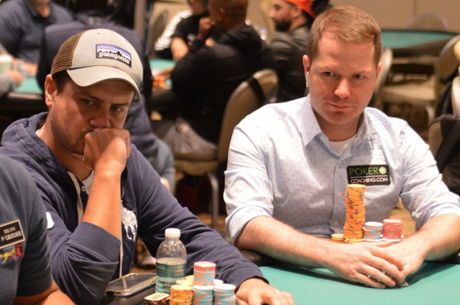How to Play Jack-Ten Suited in Cash Games (Preflop Advice & 6 Postflop Tips)

Table Of Contents
- How to Play Jack-Ten Suited Preflop
- Unopened Pots
- Against a Raise
- 1. When you’re in Middle Position through Button
- 2. From the Small Blind
- 3. From the Big Blind
- Against a 3-Bet
- Against a 4-Bet
- 1. You 3-bet from Middle Position through Button and face a 4-bet from the open-raiser.
- 2. You 3-bet from Small Blind or Big Blind.
- 3 Tips for Playing When You Miss the Flop (As the Preflop Raiser)
- Tip #1 – Always bet when you flop any real draw
- Tip #2 – Always bet when you have a backdoor flush draw
- Tip #3 – Check on super connected boards when you don’t have a real draw
- 3 Tips for Playing When You Hit the Flop
- Tip #1 – When you flop top pair in a single-raised pot, lean towards betting on the flop and checking on the turn
- Tip #2 – Never slow-play your super-strong made hands
- Tip #3 – If you have top pair plus a flush draw, double barrel more often on the turn.
- Final Thoughts
Jack-Ten suited has to be one of the prettiest hands in poker.
It’s not just a looker. Jack-Ten suited is also a very strong hand because it has a ton of playability and solid blocker effects.
This article covers:
- How to Play Jack-Ten Suited Preflop
- 3 Tips for When You Miss the Flop (As the Preflop Raiser)
- 3 Tips for When You Hit the Flop
Let’s get started.
Note: Want to test and improve your poker skills for free? Upswing Poker has dozens of free poker quizzes that will help you hone your strategy. Take a poker quiz now!
How to Play Jack-Ten Suited Preflop
Before jumping into postflop scenarios, we are going to take a look at how to play Jack-Ten suited in a variety of common preflop situations.
Unopened Pots
This hand is strong enough to be open-raised from any position. Limping this hand would only lead to smaller pots being won on average over the long-run.
Against a Raise
Your play when facing a raise should depend on your position and the position of the raiser. Let’s split this section into three groups:
1. When you’re in Middle Position through Button
There are two schools of thought, both of which can be good:
- 1. Playing a 3-bet only strategy.
- 2. Play a mixed strategy that has both 3-bets and cold-calls.
Both strategies have extremely similar expected value (EV) as long as you apply the appropriate postflop strategy.
If you want to choose a 3-bet or fold strategy, you will want to 3-bet with this hand. If you’re using a mixed strategy, then you will want to call with this hand as it’s not strong enough to 3-bet for value, nor is it weak enough to 3-bet as a semi-bluff.
2. From the Small Blind
If you play this hand from the Small Blind when facing a raise, you should always 3-bet. And you should do so almost every time. The exception is when you are against a very tight opening range in a 9-handed game.
3. From the Big Blind
When you’re in the Big Blind facing a raise, you should vary your play based on the position of the raiser.
If it was the Small Blind, Cutoff or Button who raised, you can either 3-bet or call (using a mixed frequency strategy is best according to preflop solver outputs). Against all other positions, just call and take a flop.
Against a 3-Bet
In highly raked games, which is most poker games, preflop solvers show that Jack-Ten suited should sometimes be called and sometimes be 4-bet when out of position against the 3-bettor.
There is a huge penalty for calling a 3-bet and seeing a flop when most games have a “No flop, no drop” rule in place. This is why such a powerful hand should still hit the muck against a 3-bet some of the time.
When you’re facing a 3-bet and have the advantage of position, you should almost always call with Jack-Ten suited. The exception here is when you raised from early or middle position and the player who 3-bet is a good player (with a well-built 3-betting range).
Against a 4-Bet
Not all 4-bet situations are the same, so let’s break this section down into two scenarios.
1. You 3-bet from Middle Position through Button and face a 4-bet from the open-raiser.
You should usually fold in this spot. The exception is if you are on the button facing a 4-bet from the cutoff, in which case you can call.
2. You 3-bet from Small Blind or Big Blind.
You should only call in this scenario when it is the player on the Button 4-betting. Otherwise, make the fold.
Keep in mind that it is important to consider your opponent’s 4-betting tendencies. Against a tight 4-bettor, for example, you can usually comfortably fold Jack-Ten suited to their 4-bet, regardless of your/their position.
Note: Want to know how to play every hand in every common preflop situation? Get instant access to extensive preflop charts and lessons (for cash games and tournaments) when you join the Upswing Lab training course. Lock your seat now!

3 Tips for Playing When You Miss the Flop (As the Preflop Raiser)
Tip #1 – Always bet when you flop any real draw
Jack-Ten doesn’t have any showdown value, which makes it an ideal semi-bluffing hand when you have outs to improve to a straight or flush. That includes gutshot straight draws.
Tip #2 – Always bet when you have a backdoor flush draw
When you have some type of backdoor equity like a backdoor straight draw or backdoor flush draw, then it’s best to bet. This is because it will enable you to continue (semi-)bluffing when the turn gives you a real draw.
Tip #3 – Check on super connected boards when you don’t have a real draw
I’m talking about boards such as 8♥6♥5♣ or 7♠6♠5♣.
On boards like these, Jack-Ten does have a backdoor straight draw. But because the board is so connected and better for the caller’s range, your overall strategy should be very passive in these situations.
3 Tips for Playing When You Hit the Flop
Tip #1 – When you flop top pair in a single-raised pot, lean towards betting on the flop and checking on the turn
On most boards, the top pair that you’ll hit will not be not strong enough to value bet for three streets.
Jack-Ten’s top pairs are usually worth betting two streets for value, and it’s usually better extract this value by betting flop-checking turn-betting river (rather than bet-bet-checking). This way you can pick off some bluffs from your opponent or find yourself in a clear value-bet spot on the river after the opponent checks again.
Tip #2 – Never slow-play your super-strong made hands
This tip really applies to every hand.
When you have a strong hand in poker, you should almost always lean towards building the pot ASAP. When you flop two pair, trips, a straight or a flush, you should basically always fast-play your hand.
Tip #3 – If you have top pair plus a flush draw, double barrel more often on the turn.
As previously mentioned, normally the top pairs you hit with Jack-Ten will not be not strong enough to value bet with for three streets, so you should often check the turn.
But when you have a flush draw to go with your top pair, this pushes the value of the hand just above the threshold that makes it worth betting. This happens because the hand has incentive to keep building the pot in case it hits a flush on the river.
Final Thoughts
I think this article should really clear up most of the questions you had about playing this hand.
Do you approach playing Jack-Ten suited any differently? Let me know in the comments below. Also, if you have a particular hand you’d like to see covered on this blog, feel free to let me know.
Until next time, good luck, grinders!
Note: Want to level-up your poker skills fast? Take your strategy to the next level when you join the Upswing Lab training course. Elite pros have been adding new content every week for the past four years, and you get all of it when you join. Learn more now!
Sponsor-generated content from Upswing Poker








